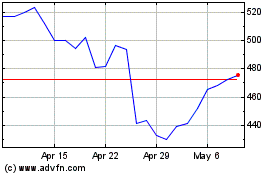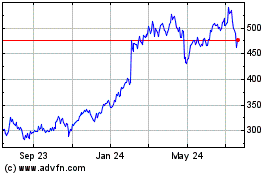By Julie Jargon
After Benjamin Gelfand made several trips to his grandparents'
house to deliver groceries in early March, he realized there must
be a lot of other elderly people who also are hesitant to leave
their homes out of fear of being exposed to the novel
coronavirus.
So he created a Google form on which at-risk neighbors can list
the grocery items and medications they need, then posted it to
several local Facebook groups in his hometown of Mequon, Wis.,
offering to deliver the items. The pre-med student, who moved back
home after the University of Wisconsin-Madison shifted to distance
learning, wears gloves when he shops and leaves the bags on the
front porch of recipients' homes. He asks that people reimburse him
for the items using Venmo or PayPal, but since many of the seniors
he is shopping for don't use digital payment apps, they slip an
envelope of cash beneath the door.
Now that many cities have instituted shelter-in-place orders,
the need to help homebound seniors is increasing. Mr. Gelfand, 19,
is one of numerous people across the country organizing grassroots
efforts to help seniors, who are among those at highest risk of
developing serious complications should they become infected.
People are mobilizing via Facebook, Instagram and Nextdoor. In my
own California community, a neighbor posted a link to a statewide
campaign to help neighbors in need at
californiavolunteers.ca.gov.
I queried parents and experts I know to learn what others are
doing and discovered that mutual-aid networks are popping
everywhere. Peanut, a networking app for moms, is mailing its
members postcards they can fill out and leave in neighbors'
mailboxes with offers to shop or run errands. In New York City,
there are local Facebook groups and Google forms where people can
sign up to bring necessities to seniors and others.
Three New Yorkers in their 20s created Invisible Hands, a
website that matches volunteers with seniors and other at-risk
people in need of food and medication. In just two weeks, the site
has attracted 7,300 volunteers who have completed 300 deliveries in
New York and New Jersey. The three friends -- a Yale University
student, a Yale graduate and New York University business major --
spread the word for volunteers through social media and posted
flyers written in multiple languages at grocery stores and
pharmacies, hoping to attract seniors.
"It sounds counterintuitive to post flyers in exactly the places
we want them to avoid, but that's where they're going," said Healy
Chait, the NYU student. "We're trying to put ourselves in the minds
of 70- and 80-year-olds to get this information to them."
Seniors who don't want to use the website can call in their
orders. The team set up Google telephone numbers that are manned by
volunteers who input the orders, which are then dispatched to other
volunteers to fill. The recipients reimburse volunteers for the
items, but neither the volunteers nor the founders accept
payment.
The three friends are considering expanding the service to other
parts of the country and are planning to add a companion calling
feature to enable lonely seniors to receive calls from
volunteers.
"I know these times are isolating and scary but while we're
alone in our homes, we are so not alone," said Liam Elkind, the
Yale student. "There's an entire army of people waiting to
help."
Of course, there are plenty of elderly people who insist on
doing everything themselves and have the tech savvy to do so. Lois
Lieberman, a 99-year-old in Los Angeles, has been ordering
groceries from Instacart and restaurant meals from Grubhub. For a
family meal on St. Patrick's Day, before she completely quarantined
herself, she watched a YouTube video on how to make corned beef and
cabbage in her Instant Pot.
"I don't think it's anything extraordinary. I just do what I
do," she said. "I don't wait for people to do things."
How to Help
Here's what you can do for seniors who do need assistance,
whether they're in your own community or located far away:
-- Join Nextdoor, the social networking website for
neighborhoods, where a lot of grassroots organizing is taking
place, community Facebook groups or the Buy Nothing Project, a
nonprofit that operates through local Facebook groups.
-- You can place online grocery orders for seniors anywhere in
the country through third-party services such as Instacart and
Shipt, as well as through Walmart, Amazon.com/Whole Foods and
directly through many major chains. Just bear in mind that it's
getting harder to do that these days. Items are often out of stock,
orders can get canceled and there are often delays, so if loved
ones or neighbors need something right away, it's better to go to
the store for them or find a volunteer in their community. (Please
follow safety advice if you must visit a grocery store and note our
tips to help you shop during the pandemic.)
-- GoGoGrandparent, a fee-based service that arranges
ride-shares for seniors who don't own smartphones, recently began
offering grocery delivery for seniors in response to the pandemic.
The company partners with delivery services, and when essential
items are out of stock, it seeks help from local volunteer groups
to procure necessities. The company also arranges restaurant
deliveries for seniors, who can call in either kind of order to
855-754-5328 or 855-464-6872.
-- You can order restaurant meals for a senior through
third-party delivery services such as Grubhub, DoorDash or Uber
Eats or directly through a restaurant's website. Some fast-food
chains, including McDonald's and Subway, are offering free delivery
for a limited time.
-- You can donate to Meals on Wheels. This meal-delivery service
for low-income seniors has a Covid-19 response fund.
-- Some local senior-support agencies are providing packaged and
frozen meals at senior centers that can be taken home. Find your
(or your loved one's) local agency at agingcare.com to see what
services they provide.
-- Many food pantries and religious groups deliver groceries or
warm meals to homebound seniors. Check foodpantries.org to find
food pantries in your (or your loved one's) area.
Whether you are ordering groceries or restaurant meals for
delivery, be sure you or the senior for whom you are ordering
follow precautions on how to safely accept deliveries.
--For more WSJ Technology analysis, reviews, advice and
headlines,
sign up for our weekly newsletter
.
Write to Julie Jargon at julie.jargon@wsj.com
(END) Dow Jones Newswires
March 31, 2020 05:44 ET (09:44 GMT)
Copyright (c) 2020 Dow Jones & Company, Inc.
Meta Platforms (NASDAQ:META)
Historical Stock Chart
From Mar 2024 to Apr 2024

Meta Platforms (NASDAQ:META)
Historical Stock Chart
From Apr 2023 to Apr 2024
